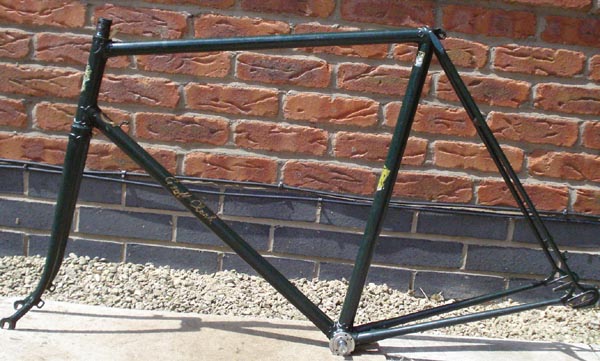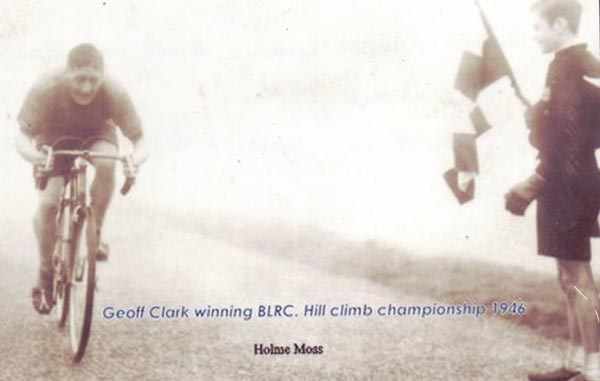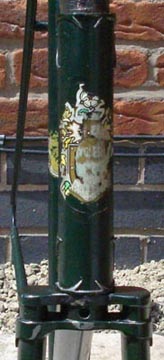Clark, Geoff
Posted: Tuesday 02nd June 2020
In over 30 years of undertaking personal research into lightweight cycle frame builders and retailers, I have never had such difficulty in establishing even the most elementary of details on a frame builder. Geoff Clark’s racing career, albeit quite short, is well documented. However, his cycle retailing career isn’t so.

I have to mention at this point, that I wouldn’t have been able to compile this short history without the invaluable assistance of a number of people including first and foremost, Derek Browne fellow V-CC member, who was responsible for doing virtually all of the leg-work on my behalf, who, lives locally to Bradford and the locations associated with Geoff; Ken Russell, famous international racing cyclist, friend and rival of Geoff’s; Richard Hoddinott (V-CC), whom I must blame for first getting me into this situation by selling me one of Geoff Clark’s first frames; Tony Tomkins, V-CC member and fellow Bradford Racing Cyclists Club (BRCC) member of Geoff Clark. Plus a number of enthusiasts who currently own examples of Geoff’s frames.
Geoff Clark was born in 1923 and came to prominence during the period of the Second World War, when he was a successful Bradford Racing Cyclists Club (BRCC) cyclist and competitor. He became one of the founding 24 cyclists led by Percy Stallard of Wolverhampton, in establishing the B.L.R.C. in 1942* and arguably one of the most influential people in the road racing movement at this time, in the opinion of Derek Browne and Ken Russell.
I have yet to establish how Geoff wasn’t called up for military service during WWII as he would have been 19 at this time. It has been suggested that it was colour blindness, but this wouldn’t have precluded an administrative role of some kind. Clearly he was incredibly fit and was an entry in the first B.L.R.C. Road Race – Llangollen to Wolverhampton in 1942, along with 32 other competitors which, interestingly, didn’t include Percy Stallard!* (He was the organizer).
He rode in the first National RR Championship, 1943; the first Stage Race in Gt. Britain over the August Bank Holiday, 1944*. Although the results of his placing are not known at this stage. In the post war years he participated in the first ‘Victory Tour’ – Brighton to Glasgow, held in 1945 over 5 days and 542 miles, finishing second overall and winning one stage, the London to Wolverhampton. This race was the one, famously illustrating the three Taylor brothers, Jack, Norman and Ken as participants, who came 10th, 13th and 14th respectively. Notably Percy Stallard finished 15th.*
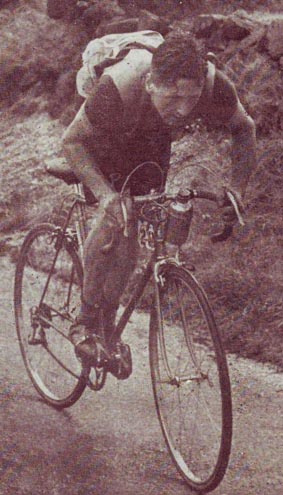
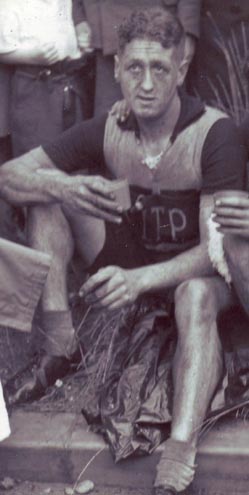
In 1948 Geoff again, won the London to Wolverhampton stage of the Brighton to Glasgow RR, eventually finishing 4th overall.* He was to avenge his earlier results by eventually winning the famous British RR in 1949, and the longest stage, Bradford to Newcastle (125 miles).* That same year Geoff famously raced in the Tour of Poland, winning the Katowice – Zacopane stage and almost winning the entire race as the strongest rider in the field. However, he crashed two days from the finish and had to retire.
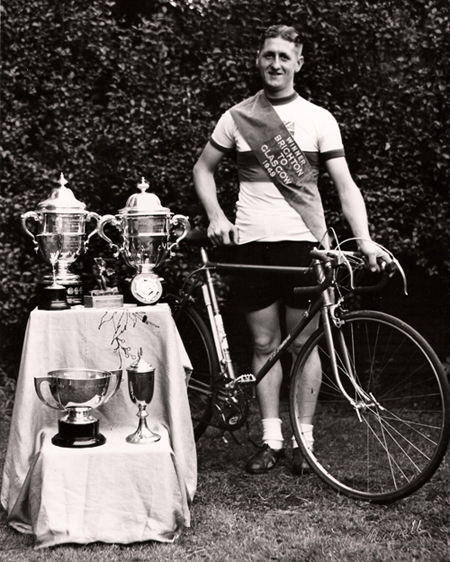
During 1949 he rode a Percy Stallard cycle, which Stallard capitalized on by naming the frame the ‘Zacopane’ model, after Geoff’s stage win, and featured it, and him, on the front cover of their late 1949 catalogue^. During 1950, Geoff by this time had turned Independent and rode under the International Totaliser Pool Team colours alongside contemporaries of the day, Ken Russell (later to win the 1952 Tour of Britain), Ken Jowett, Frank Steel and Eric Mitchell.+
In the Brighton to Glasgow Programme, Geoff’s occupation is listed as Motor (Auto) Electrician. By 1951 the same programme now quoted his occupation as Electrician and Cycle builder.
At first, when trying to fathom out actually when Geoff had started to put his name to a frame, I was confused as to how this juxtaposed to his cycling activities, which clearly required extensive training programmes and travel to actual events, both in the UK and internationally.
The frame which first ‘kick-started’ my quest for knowledge about the man and his career is a superb, but simple example of a circa 1950, first-generation Nervex Pro lugged frame built with such fine detail and finishing, it suggested that it simply couldn’t have been built by a novice frame builder. Yet here was a frame built at a time when Geoff was winning races! I have since learnt that although it bears, along with a known earlier extant frame, the name of Geoff Clark, it was in fact built by an ex Ellis-Briggs builder by the name of Sunter (Christian name unknown), who in turn was taught by Jack Briggs. My frame has all the hall-marks of Briggs detailing it would seem, and copied by Sunter’s building technique.
There is still some confusion as to when frame building commenced as, Richard Hoddinott owns the earliest known frame, numbered 9, purchased it from its original owner who claimed he watched it being built in 1947. My frame, numbered 107, is clearly a circa 1950 frame, judging by its frame build features and braze-ons etc.
The numbering at this time appears to be unique for GC. But I will expand on this a little later.
Frame building in around 1950/1 was undertaken in Geoff’s auto electrical premises, which was as a shed-come-garage at Newall Street, Bradford. For frames to have climbed from 9 to 107, by 1950 there must have been a period of a year or so when frame building took place. So it is quite likely that the earliest frames were built here in the late forties, although it was not generally known that Geoff was having frames built with his name on at this time. Ken Russell seems certain that he didn’t start until around 1950. But if my frame (which still bears its original livery) is No. 107, clearly he must have had building done some time earlier than this, in my view.
Derek Browne’s Clark frame numbered 142, is dated to 1953 as it too was purchased from its original owner, Phil Ellison. Derek’s cycle can be seen on the CL website.
It would appear that Geoff Clark moved premises quite frequently throughout his retailing career for a small business, and although I have yet to establish exactly when Sunter and he parted company, I have been advised that Sunter did give Clark some tuition in frame building, along with a later employee and ex-racing team colleague, Ken Jowett, who also trained as a frame builder at Whitaker and Mapplebeck before going to work for Geoff Clark..
Although it is known now that he frequently used a variety of established frame builders in the area including that of, Whitaker & Mapplebeck (Pennine fame); Woodrup (from mid 70’s) and MKM later, we have learnt from an ex-employee at Woodhead Road premises, Paul Holliman, that Geoff built all his own frames during the 1960’s. I guess that during this era there wouldn’t have been that many lightweights being ordered.
It is during this period that frame numbering took on that of the trade builder although we don’t know if Geoff’s own system was continued from the 1950’s or not.
After GC’s early days of trading by 1952 we do know from an advertisement in Leaguer, he was trading from his first shop at 59 Newall St, Manchester Road, Bradford which was adjacent to his old garage premises. These premises were demolished in the late 1970’s/80’s for a road widening programme. From 1954 to 1959 he traded from 143 Manningham Lane with a workshop in a back road on the opposite side of the road.
By the early 1960’s he was working from a typical corner-shop at Horton Grange Road which had a workshop at the rear and living accommodation above. He moved again during the mid to late-60’s to much larger recently built double-fronted premises at Arncliffe Terrace, off Woodhead Road. Derek Browne says that this shop must have been the largest cycle retail shop in Bradford, if not the whole of West Yorkshire at the time. So he clearly must have been doing well despite the overall downturn in lightweight cycling at this time.
This is further reflected in the last premises from which Geoff traded in the early 1970’S which was a unit in Prospect Mills, Thornton Village area of Bradford which by this time he was trading part-time with his daughter, Andrea. The unit in question is the single-story one at the end of the old Mill, which is now derelict.
Sadly it is known that that all his stock was stolen prior to a Christmas during the 70’s which became his final year of trading. At this time he was also working part-time building up bicycles for Grattan Warehouse mail order catalogue people – now defunct, until he retired.
At the time of writing Geoff is still alive although sadly, suffering from a stroke, dementia and resides in a care home somewhere in his beloved Bradford area.
I have established a frame register with seven extant frames so far, dating from late 1940’s (number 9 as mentioned previously) to 479.
There were just two transfer designs during the whole of the frame building period. The first is a ‘signature’ script type down tube version with a simple crest/shield design for the head/seat tubes and the later 60’s onwards the slanted, serifed, block capital version, as can be seen on Derek Brownes cycle on this website along with a crest reflecting the City of Bradford design for the head and seat.

One of the owners on the small register happens to be a graphic artist and he has replicated the early, original design onto water slide transfers for anyone wishing to refurbish their frames of the correct period. Contact the writer, via the website, if you wish to purchase a set of these which are very reasonably priced for hand produced transfers.
I welcome any further information from anyone about Geoff Clark and his retailing career and also, of course, of any known frame and numbers known to survive.
• * Ride and be Damned – Chas Messenger
• ^ Lightweight Cycle Catalogue Vol. 1 – V-CC JpMPF
• + BLRC Race programmes 1950/51
When I started to ride for Ron Kitching in 1970 – my old cyclo X frames – which were built by Harry Quinn in Liverpool – and my new ones, also by Harry were in fact painted by Geoff Clark in the shop in Bradford.. I cannot remember lads name who did the spraying – but they were done there every year till 1975…even my road and track bikes were re-done at Geoff Clarke…
Posted: Tuesday 02nd June 2020
This article appears in the following categories.
Upcoming Events
Whether you are looking for a gentle social meet up, or a 100-mile ride browse the community’s upcoming events and plan your next weekend outing.

